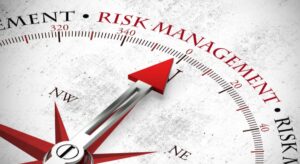Banks declaring bankruptcy are common. What if your hard-earned money is never returned to you? You will be made at the banking system, right? To avoid such situations risk management systems for banks have been introduced by the Government. Banking systems form the base of the financial ecosystem across the world. They are trusted depositories, trusted credit lending institutions, and trusted monetary transaction partners.
Table of Contents
Why Risk management for banks is required?
Banks need supervision like any other institution. Thus, rating tools and methods are used for risk management for banks. They need to follow rules, regulations, and ethics to safeguard the interests of the depositors. Since banks are the foundations of the monetary ecosystem, their transactions must be audited and supervised to avoid any collapse of the financial system. Basel norms, CAMELS, and AIRB (Advanced Internal Ratings-Based) approaches are used to maintain the financial health of the banks.

Risk management systems for banks:
Advanced Internal Rating-Based (AIRB)
It is a risk measurement tool for banking and financial institutions that helps in the measurement of credit risk. It is done under the Basel II Capital Rules for institutions and companies that specialize in banking globally. It involves measuring the credit risk to which banks are exposed along with the magnitude of credit risk and its severity it.
Risk management systems and measures for banks include below components of measuring risks:
- Probability of default (PD) -It measures the probability of borrowers defaulting on loan repayments. A lender lends money to the borrower to earn income by way of interest earned on the investments. If the borrower defaults on the payment, the lender not only loses the interest income but may also lose its entire investment amount if the loan becomes a bad debt.
PD = Expected loss/(EAD x LGD)
PD – the probability of default – It is expressed as a percentage
EAD – Exposure at default – It is the current balance at default.
LGD – Loss-given default – It measures the net loss percentage of defaulted loans.
Example:
Suppose you are a credit risk analyst at a bank, and you need to estimate the PD for a corporate borrower, ABC Manufacturing Inc., over the next 12 months. Here’s how you might approach it:
- Data Gathering:
- Collect relevant data about ABC Manufacturing Inc., including its financial statements, credit history, industry trends, and any qualitative information about the company’s management and operations.
- Historical Default Data:
- Examine historical data on default rates for companies in the same industry or with similar financial profiles. This data might come from internal records, industry databases, or credit rating agencies.
- Financial Ratios:
- Analyze financial ratios that are indicative of a company’s creditworthiness. These ratios may include debt-to-equity ratio, current ratio, interest coverage ratio, and others.
- Credit Scores:
- If available, consider credit scores assigned by credit rating agencies to ABC Manufacturing Inc. These scores provide a standardized assessment of credit risk.
- Qualitative Factors:
- Take into account any qualitative factors that may affect ABC Manufacturing Inc.’s credit risk, such as recent management changes, legal issues, or changes in the competitive landscape.
- Modeling:
- Combine all the information and data you’ve gathered to build a credit risk model. The model may use statistical techniques such as logistic regression, machine learning algorithms, or expert judgment to estimate the PD.
- PD Estimation:
- After analyzing the data and running the model, you arrive at an estimated PD. For example, your model might estimate a 1-year PD of 2%, meaning there is a 2% probability that ABC Manufacturing Inc. will default on its obligations within the next year.
- Validation:
- It’s essential to validate the PD estimate to ensure its accuracy and reliability. This can involve back-testing the model against historical data or comparing the estimated PD to actual default outcomes for a similar set of borrowers.
- Monitoring:
- Credit risk is dynamic, and PD may change over time due to economic conditions, company performance, or other factors. Banks regularly monitor the creditworthiness of their borrowers and update PD estimates accordingly.
- Risk Management:
- PD estimates are used for risk management purposes, such as setting credit limits, pricing loans, and determining the amount of regulatory capital required to cover potential losses.
In summary, Probability of Default (PD) is a critical metric used in credit risk assessment to quantify the likelihood of a borrower defaulting on its obligations. It involves data collection, analysis, modeling, and validation to arrive at an estimate that informs credit decisions and risk management strategies. Accurate PD estimation is essential for banks and financial institutions to effectively manage credit risk and make informed lending decisions
Consider the below points when considering credit risk exposures:
- Defaults are relatively rare events compared to market losses. The lack of available data is an issue for both calibrating the models as well as backtesting.
- Correlations between failures have a significant impact on the final result. They should not be underestimated.
- Wrong-way exposure (growing utilization of credit cards in case of an increase in PD should be taken into account. In case of deterioration of the situation, both the PD and LGD may worsen. An assumption of their mutual independence is not realistic.
- Concentration risk should be taken into account in the loan portfolio, mainly in the case of its low granularity.
- Credit exposures are not only subject to the idiosyncratic risk of individual borrowers or counterparties but to the systemic risk as well. For example, a drop in real estate prices will negatively affect the whole construction industry; changes in FX rates can have an impact on exporters).
- The loss distribution has fat tails and is not symmetric.
- Risk-weighted Assets – The risk-weighted assets indicate a minimum capital requirement for banks. Risk management systems for banks suggest maintaining adequate capital to meet daily obligations without delay. It also allocates risks to different assets to ensure that the bank can absorb any shocks in case of unfavorable situations. Risk-weighted assets determine the risk-absorbing ability of the banks. Weights are allocated to assets like capital, deposits, cash, and investments to determine the maximum risk that a bank can assume while not triggering red flags.
For example – As an incentive to banks, the RBI had also spelled out reduced risk-weights as under for accounts rated by the accredited agencies:
- 20% risk-weight: AAA-rated
- 30% risk-weight: AA-rated
- 50% risk-weight: A-rated
- 100% risk-weight for lower ratings
- 150% for unrated.

Example: Calculating Risk Weighted Assets for a Bank
Let’s consider a hypothetical bank, XYZ Bank, and three types of credit exposures it holds:
- Corporate Loans: XYZ Bank has a portfolio of corporate loans with a total exposure of $50 million.
- Residential Mortgages: The bank also has a portfolio of residential mortgages with a total exposure of $30 million.
- Government Bonds: XYZ Bank holds government bonds with a total exposure of $20 million.
Now, let’s calculate the RWA for each of these exposures:
Step 1: Assigning Risk Weights
In the Basel framework, different asset classes have predefined risk weights. These risk weights reflect the perceived credit risk of each asset class. For our example, we’ll use simplified risk weights:
- Corporate Loans: 100% risk weight
- Residential Mortgages: 35% risk weight
- Government Bonds: 0% risk weight
Step 2: Calculating RWA
- Corporate Loans:
- Exposure Amount: $50 million
- Risk Weight: 100%
- RWA for Corporate Loans = Exposure Amount x Risk Weight = $50 million x 100% = $50 million
- Residential Mortgages:
- Exposure Amount: $30 million
- Risk Weight: 35%
- RWA for Residential Mortgages = Exposure Amount x Risk Weight = $30 million x 35% = $10.5 million
- Government Bonds:
- Exposure Amount: $20 million
- Risk Weight: 0%
- RWA for Government Bonds = Exposure Amount x Risk Weight = $20 million x 0% = $0
Step 3: Total RWA Calculation
Now, we sum up the RWAs for each exposure to calculate the total RWA for XYZ Bank:
Total RWA = RWA for Corporate Loans + RWA for Residential Mortgages + RWA for Government Bonds Total RWA = $50 million + $10.5 million + $0 = $60.5 million
So, the total Risk Weighted Assets (RWA) for XYZ Bank’s credit exposure is $60.5 million. This means that XYZ Bank is required to hold regulatory capital against this RWA amount to cover potential credit losses based on the assigned risk weights.
It’s important to note that this is a simplified example, and in practice, RWA calculation can be more complex, involving various adjustments, risk mitigants, and more granular risk weight categories based on the specific characteristics of assets and exposures. Banks must adhere to regulatory guidelines and reporting requirements for accurate RWA calculations.
Credit risks
Credit risk is a risk of a loss resulting from the fact that a borrower or counterparty fails to fulfill its obligations under the agreed terms. It consists of the following risks:
- Sovereign risk is the risk of a government or central bank being unwilling or unable to meet its contractual obligations.
- Concentration risk is the risk resulting from the concentration of transactions about a person, a group of economically associated persons, a government, a geographic region, or an economic sector. It is the risk associated with any single exposure or group of exposures with the potential to produce large enough losses to threaten a bank’s core operations, mainly due to a low level of diversification of the portfolio.
- Settlement risk is the risk resulting from a situation when a transaction settlement does not take place according to the agreed conditions. For example, when trading bonds, it is common that the securities are delivered two days after the trade has been agreed and the payment has been made. The risk that this delivery does not occur is called settlement risk.
- Counterparty risk is the credit risk resulting from the position in a trading instrument. As an example, this includes the case when the counterparty does not honor its obligation resulting from an in-the-money option at the time of its maturity.
Third party risk management for banks
Third-party risk management for banks is a critical process that involves assessing, monitoring, and mitigating the risks associated with the use of third-party vendors, service providers, or partners. Banks often rely on third-party relationships to support various aspects of their operations, such as technology, compliance, outsourcing, and more. However, these relationships can introduce various risks that need to be managed effectively. Here are some key aspects of third-party risk management for banks:
- Risk Assessment and Due Diligence:
- Banks should conduct thorough due diligence when selecting third-party vendors or partners. This includes evaluating their financial stability, reputation, regulatory compliance, and security controls.
- Assess the potential risks and impact of third-party relationships on the bank’s operations, compliance, reputation, and customers.
- Contractual Agreements:
- Establish clear contractual agreements with third parties that outline roles, responsibilities, and expectations. These contracts should also include terms related to data security, confidentiality, compliance, and dispute resolution.
- Ensure that the contracts are reviewed and approved by legal and compliance teams to align with regulatory requirements.
- Risk Categorization:
- Categorize third-party relationships based on their criticality and impact on the bank. High-risk relationships may require more rigorous monitoring and controls.
- Develop risk rating frameworks to assign risk scores to different vendors or partners.
- Ongoing Monitoring:
- Continuously monitor the activities of third-party vendors to ensure they adhere to contractual agreements and regulatory requirements.
- Regularly assess the third party’s financial health and ability to meet their obligations.
- Security and Data Protection:
- Evaluate the third party’s information security and data protection practices to ensure they align with the bank’s security standards.
- Implement measures to protect sensitive customer data when it is shared with third parties.
- Compliance and Regulatory Adherence:
- Ensure that third-party relationships comply with all relevant regulations and laws. This includes areas such as anti-money laundering (AML), Know Your Customer (KYC), and data privacy.
- Stay updated on changing regulatory requirements and incorporate them into the third-party risk management program.
- Contingency Planning:
- Develop contingency plans to address potential disruptions caused by third-party failures, such as data breaches, service interruptions, or financial instability.
- Establish alternative arrangements or backup plans to maintain critical operations.
- Reporting and Documentation:
- Maintain detailed records of third-party relationships, assessments, due diligence, and ongoing monitoring activities.
- Provide regular reports to senior management and the board of directors regarding the status of third-party risks.
- Exit Strategy:
- Develop exit strategies that allow the bank to transition away from a third-party relationship if necessary.
- Define the process for contract termination and data retrieval.
- Training and Awareness:
- Train bank employees involved in managing third-party relationships to understand the risks and best practices.
- Foster a culture of risk awareness and accountability throughout the organization.
Effective third-party risk management is essential for banks to safeguard their operations, protect customer data, maintain regulatory compliance, and uphold their reputation in the financial industry. It requires ongoing vigilance and a proactive approach to identifying and mitigating potential risks.
FunFact:
RBI in India has prescribed a credit rating for all loan assets. Credit rating agencies like ICRA, CARE, CRISIL, and Fitch India which earlier only evaluated and rated credit and market risks for companies/entities going public, or for listed companies that raised long-term domestic and external debt have been designated as approved agencies by the RBI for credit rating of all bank borrowers.
Any thoughts on risk management for banks?

